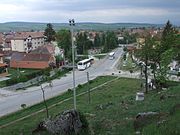Cârța, Harghita
Cârța
Karcfalva, Csíkkarcfalva | |
|---|---|
 Fortified church | |
 Location in Harghita County | |
| Coordinates: 46°32′N 25°45′E / 46.533°N 25.750°E | |
| Country | Romania |
| County | Harghita |
| Government | |
| • Mayor (2020–2024) | Tibor Gábor[1] (UDMR) |
| Area | 78.36 km2 (30.25 sq mi) |
| Elevation | 721 m (2,365 ft) |
| Population (2021-12-01)[2] | 2,527 |
| • Density | 32/km2 (84/sq mi) |
| Time zone | EET/EEST (UTC+2/+3) |
| Postal code | 537035 |
| Area code | +40 266 |
| Vehicle reg. | HR |
| Website | primariacirta |
Cârța (Romanian: [ˈkɨrtsa]; Hungarian: Csíkkarcfalva or Karcfalva [ˈ(t͡ʃiːk)kɒrt͡sfɒlvɒ]) is a commune in Romania, located in Harghita County. It lies in the Székely Land, an ethno-cultural region in eastern Transylvania. The commune is composed of two villages: Cârța (Karcfalva) and Ineu (Csíkjenőfalva). Tomești has been an independent commune since 2004.
History[edit]
The village belonged to the Székely seat of Csíkszék, then from 1876 until 1918 to the Csík County in the Kingdom of Hungary. In the aftermath of World War I and the Hungarian–Romanian War of 1918–1919, it passed under Romanian administration; after the Treaty of Trianon of 1920, like the rest of Transylvania, it became part of the Kingdom of Romania. During the interwar period, the village fell within Ciuc County. In 1940, the Second Vienna Award granted Northern Transylvania to Hungary and the village was held by Hungary until 1944. After Soviet occupation, the Romanian administration returned and the village became officially part of Romania in March 1945. Between 1952 and 1960, the commune fell within the Magyar Autonomous Region, between 1960 and 1968 the Mureș-Magyar Autonomous Region. In 1968, the region was abolished, and since then, the commune has been part of Harghita County.
Demographics[edit]
At the 2011 census, the commune had a population of 2,709; out of them, 98% were Hungarian and 0.3% were Romanian.[3] 97% of the commune population are Roman Catholic, 1% are Reformed and 0.4% are Orthodox.[4]
Landmarks[edit]
- Its Roman Catholic church dedicated to honour of Virgin Mary was built around 1448 by rebuilding an older church from donation of John Hunyadi. It was altered in 1720, 1796, and in 1922. Its fortified walls were built in the late 18th, early 19th centuries. The design of the defense corridors is unique in the Székely Land. The church tower was heightened in 1720 and covered with tin sheets in 1850. A great number of pagan ritual objects were found here in 1796 when the church was being altered.
- Madicsa, a village notable of its mineral water source, lies 4.4 km (2.7 mi) west of the village. There is a mineral water bath in the village.
Natives[edit]
- Albert-László Barabási, physicist
- Hunor Kelemen, politician and writer
Twinnings[edit]
External links[edit]
- Tourist information
- General information (in English)
References[edit]
- ^ "Results of the 2020 local elections". Central Electoral Bureau. Retrieved 9 June 2021.
- ^ "Populaţia rezidentă după grupa de vârstă, pe județe și municipii, orașe, comune, la 1 decembrie 2021" (XLS). National Institute of Statistics.
- ^ Tab8. Populaţia stabilă după etnie – judeţe, municipii, oraşe, comune, 2011 census results, Institutul Național de Statistică, Retrieved 19 February 2020.
- ^ Tab13. Populaţia stabilă după religie – judeţe, municipii, oraşe, comune, 2011 census results, Institutul Național de Statistică, Retrieved 19 February 2020.







